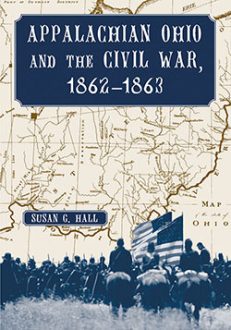Appalachian Ohio and the Civil War, 1862–1863
$39.95
In stock
About the Book
The antebellum culture of Harrison County (birthplace of George Armstrong Custer) and the surrounding five-county area of Appalachian east Ohio was an outspoken, democratic society—and a way station of the Underground Railroad for escaping slaves. With the coming of the Civil War, this community faced momentous change and bitter divisions. This narrative history provides a portrait of the area and the ways in which the war affected everyone. Portions of letters and diaries from the soldiers and those who loved them, illustrations and maps are included.
About the Author(s)
Bibliographic Details
Susan G. Hall
Format: softcover (7 x 10)
Pages: 264
Bibliographic Info: 5 photos, 10 maps, bibliography, index
Copyright Date: 2008 [2000]
pISBN: 978-0-7864-3738-2
eISBN: 978-1-4766-0834-1
Imprint: McFarland
Table of Contents
Preface 1
Sources 4
Notes 6
1. The Land and Its People 7
2. Fourth of July 1862: “The War Is Almost Over Now” 25
3. “‘Lay on McDuff’ &c” 31
4. Kentucky: The School for the Soldier 42
5. “Most Respected Friend Nancy” 55
6. “Here I Am Bound to Blaze” 59
7. Nancy’s News 72
8. Perryville: “Nobody Sees a Battle” 77
9. Correspondences 99
10. Reapers in Motion 105
11. The Cedars of Lebanon, Kentucky 112
12. Cumberland, Maryland: “The Wild Romantic Scenes” 120
13. “A School of Crime and Sin” 131
14. Christmas and New Year’s Greetings 139
15. “War Is a Lottery” 150
16. Orations of the Nation: The War Debate That Heralded the Gettysburg Address 156
17. Peace Clarions, Threnodies, and Wolf Calls 167
18. Martinsburg, Virginia, and Its Symbols 173
19. Spring Returns 185
20. A Marching Band in the Virginia Mountains 194
21. May: A Mob in the Streets 200
22. Mudsills Amid the Tennessee Chivalry 204
23. June: Butternuts and Black Soldiers 212
24. Under Fire in Tennessee, Mississippi, Virginia 218
25. Morgan’s Raid and the Soldiers 231
Works Cited or Used 244
Index 251
Book Reviews & Awards
“readers will gain a sense of local color and the historical period”—Public Library Quarterly; “skillfully intertwines the story of the men who marched off to war from Appalachian Ohio with the turbulent political history of the communities that sent them”—Crossfire; “this work is notable in its scope…bibliography [is] excellent…Hall’s effort is commendable”—The Filson History Quarterly.





